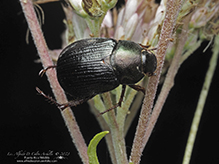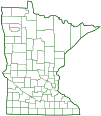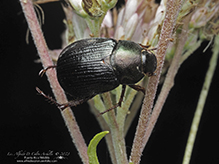Oriental beetle
(Exomala orientalis)
Conservation • Description • Habitat • Ecology • Distribution • Taxonomy
|
|
||||||||||||||
Description |
Oriental beetle is an exotic, extremely variable, small to medium-sized, shining leaf chafer beetle. It is native to Japan. It was accidentally introduced into North America in infested nursery stock, and it was established in the United States before 1920. It now occurs in the U.S. from Maine to Virginia, west to Wisconsin and eastern Texas. It occurs in southern Canada from Nova Scotia to eastern Ontario. It has not been recorded in Minnesota – yet. The slow spread of this beetle is believed to be because it is not a strong flier. It is introduced into new areas in shipments of nursery stock, when adults may be hidden in flowers and larvae may be present in the soil. Adults are active from early June to August. Their preferred habitat is frequently mowed lawns. They feed on flowers. The larvae live in the soil and feed on the roots of a wide variety of plants, including most grasses, ornamental plants, and many vegetable crops. Oriental beetle is considered an agricultural pest of corn, highbush blueberries, pineapples, sugarcane, and strawberries. It is a serious pest of turf grasses, including in golf courses. It is also a pest of nursery stock and potted plants that are grown outdoors. Adults are ¼″ to ½″ (7.0 to 13.0 mm) long and 3⁄16″ to ¼″ (4.5 to 6.0 mm) wide. The body is oval oblong shaped when viewed from above, convex when viewed from the front. It has a slight metallic sheen. The coloration is extremely variable. It may be entirely straw-colored (pale), pale with dark markings, or entirely black. The head is large. The antennae have nine segments. The last three segments are expanded sideways on one side into long flattened lobes. The antennal lobes can be closed into a tight club or fanned out to detect odors. The club is bare, not velvety. The mouthparts are directed downward. They are inconspicuous and are not visible from above. The plate covering the first segment of the thorax (pronotum) is usually pale with a pair of large black spots. However, it may also be entirely pale or entirely black. It is not hairy. The lateral margins have a narrow but distinct expansion (bead). The bead is set off by a distinct groove. The small plate between the wing bases (scutellum) is visible, not concealed by the wing covers (elytra). The head, pronotum, and scutellum are densely but shallowly pitted (punctate). The elytra do not entirely cover the abdomen, leaving the last segment partially exposed. They are usually pale with a black spot at the base near the inner margin and one or two black U-shaped bands. Sometimes they are entirely pale or entirely black. The surface is shallowly punctate. On each elytron there is an elevated knob (umbone) in the shoulder (humeral) area. There are six shallow but distinct grooves between the inner margin and the humeral umbone. The legs are strong and are adapted for burrowing. On the middle legs, the fourth segment (tibia) has two spurs at the tip. The last part of each leg (tarsus), corresponding to the foot, has five segments. There is a pair of claws at the tip of the last segment. The claws are unequal in size and are independently movable. On the front and middle legs, the larger claw is obviously split at the tip. |
Size |
Total length: ¼″ to ½″ (7.0 to 13.0 mm) |
Similar Species |
Habitat |
Lawns, gardens, plant nurseries, and agricultural crops |
Ecology |
Season |
One generation per year: Early June to August |
Behavior |
Adults are not strong fliers |
Life Cycle |
The female burrows into the soil to a depth of 1″ to 9″ (2.5 to 23 cm) and deposits a single egg. She probably lays about 25 eggs in her lifetime. When the eggs hatch, the larvae burrow through the soil to a depth of 4″ to 8″ (10 to 20 cm), and feed on plant roots. When temperatures drop to freezing, they burrow deeper, 8″ to 16″ (20 to 42 cm) below the surface. They spend the winter in a relatively inactive state. In early April, they return to root depth and continue feeding. In late April, each larva creates a cell by packing earth, and pupates within the cell. Adults emerge in early June. |
Larva Food |
Roots of a wide variety of plants |
Adult Food |
Flowers |
Distribution |
||
|
Sources |
|
| 3/11/2024 | ||
Occurrence |
||
Not recorded in Minnesota … yet |
||
Taxonomy |
|
Order |
Coleoptera (Beetles) |
Suborder |
Polyphaga (Water, Rove, Scarab, Long-horned, Leaf, and Snout Beetles) |
Infraorder |
Scarabaeiformia |
Superfamily |
Scarabaeoidea (Scarabs, Stag Beetles, and Allies) |
Family |
Scarabaeidae (scarabs) |
Subfamily |
Rutelinae (shining leaf chafers) |
Tribe |
Anomalini |
Genus |
Exomala |
Considerable controversy and confusion has surrounded the placement of this species into a genus. The beetle was originally described as Phyllopertha orientalis in 1875. Since then, it has been moved into and out of the genera or subgenera Anomala, Exomala, and Phyllopertha. In 1991, an article (Baraud J, 1991) proposed raising Exomala, a subgenus of Blitopertha, to full species rank. Since then, the species has been referred to as either Exomala orientalis or Anomala orientalis. Currently, Exomala orientalis is the preferred name. |
|
Subordinate Taxa |
|
|
|
Synonyms |
|
Anomala orientalis Blitopertha orientalis flavipennis Exomala flavipennis Exomala tanbaensis Exomala xanthogastra Phyllopertha orientalis Phyllopertha tanbaensis Phyllopertha xanthogastra |
|
Common Names |
|
Asiatic beetle Oriental beetle spotted chafer |
|
Glossary
Elytra
The hardened or leathery forewings of beetles used to protect the fragile hindwings, which are used for flying. Singular: elytron.
Pronotum
The exoskeletal plate on the upper side of the first segment of the thorax of an insect.
Punctate
Dotted with pits (punctures), translucent sunken glands, or colored spots of pigment.
Scutellum
The exoskeletal plate covering the rearward (posterior) part of the middle segment of the thorax in some insects. In Coleoptera, Hemiptera, and Homoptera, the dorsal, often triangular plate behind the pronotum and between the bases of the front wings. In Diptera, the exoskeletal plate between the abdomen and the thorax.
Tarsus
On insects, the last two to five subdivisions of the leg, attached to the tibia; the foot. On spiders, the last segment of the leg. Plural: tarsi.
Tibia
The fourth segment of an insect leg, after the femur and before the tarsus (foot). The fifth segment of a spider leg or palp. Plural: tibiae.
Visitor Photos |
||
Share your photo of this insect. |
||
This button not working for you? |
||
Alfredo Colon |
||
 |
||
 |
||
MinnesotaSeasons.com Photos |
||
|
||
|
||

Slideshows |
|

Visitor Videos |
||
Share your video of this insect. |
||
This button not working for you? |
||
|
Other Videos |
||
セマダラコガネExomala orientalis [黒色型] の防御行動 |
About
Jun 18, 2016 2016年6月18日午後、山口市徳地町の山間部で撮影しました。 |
セマダラコガネ 接写 Oriental Beetle (Exomala orientalis) Close Up |
About
Jun 10, 2016 愛嬌のある顔をしています。 2016-06-10 仙台市西公園 Nishi Park, Sendai City, Miyagi Prefecture, Japan COOLPIX L610 |

Visitor Sightings |
||
Report a sighting of this insect. |
||
This button not working for you? |
||
Alfredo Colon |
Location: Albany, NY |
 |
Alfredo Colon |
Location: Albany, NY |
 |
Alfredo Colon |
Location: Albany, NY |
 |
MinnesotaSeasons.com Sightings |
||
|

Created: 3/11/2024 Last Updated: © MinnesotaSeasons.com. All rights reserved. |

